Approaches to Leadership/Management in Global Context Report
VerifiedAdded on 2020/10/22
|11
|2585
|485
Report
AI Summary
This report delves into the crucial aspects of leadership and management within a globalized business environment. It begins by outlining the functional areas and hierarchical structure of Nisa Retail Ltd, a UK-based grocery wholesaler, and then explores the vital role of effective communication in both management and leadership. The report further examines the drivers of globalization, such as market, economic, and technological factors, and their subsequent impact on business operations. A comparative analysis of leadership styles, specifically autocratic and democratic approaches, is provided, highlighting their strengths and weaknesses. The report concludes by emphasizing the significance of adopting effective leadership and management strategies for businesses aiming to thrive in the global market. The analysis covers the importance of organizational structure, communication channels, and the influence of globalization on business practices. Desklib provides past papers and solved assignments for students to enhance their understanding of these concepts.
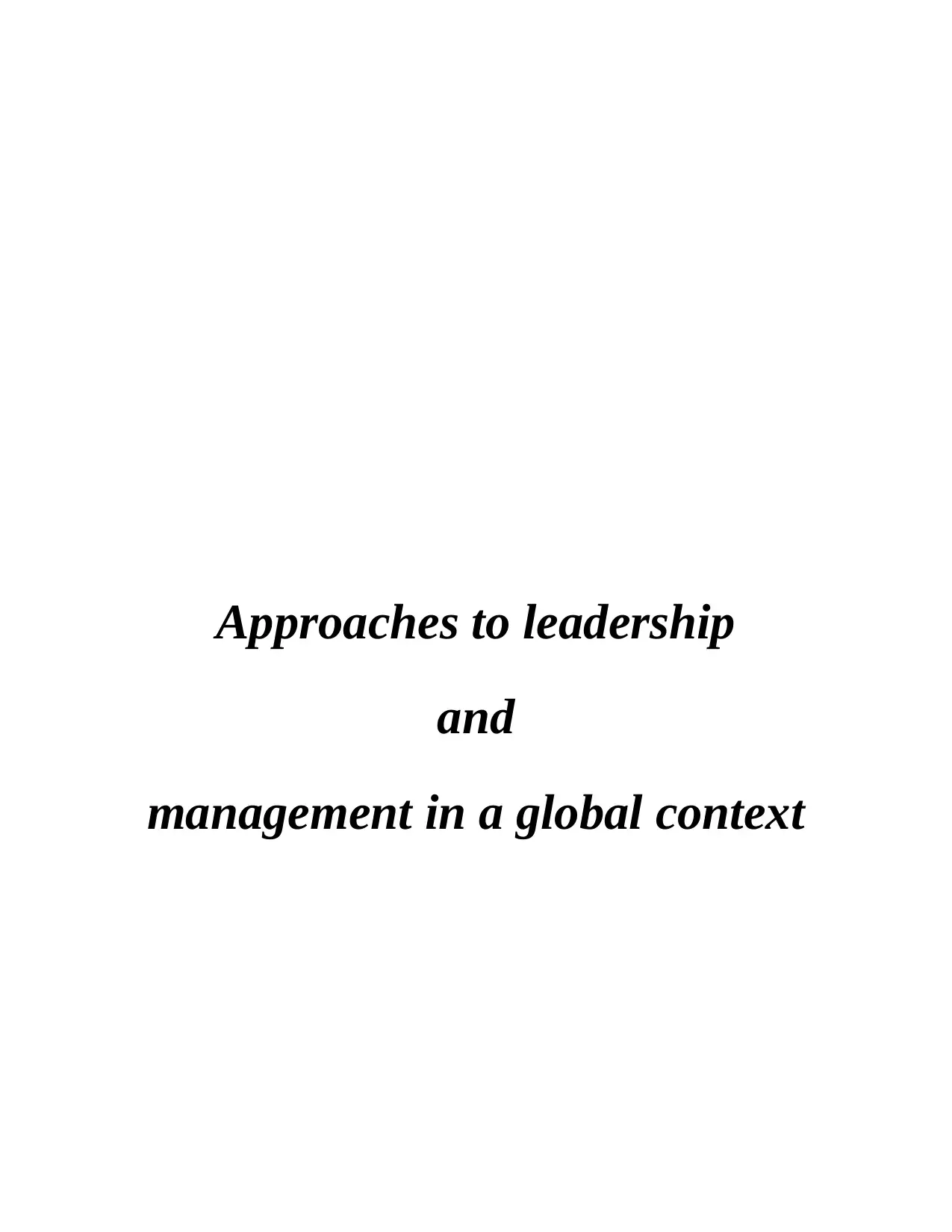
Approaches to leadership
and
management in a global context
and
management in a global context
Paraphrase This Document
Need a fresh take? Get an instant paraphrase of this document with our AI Paraphraser
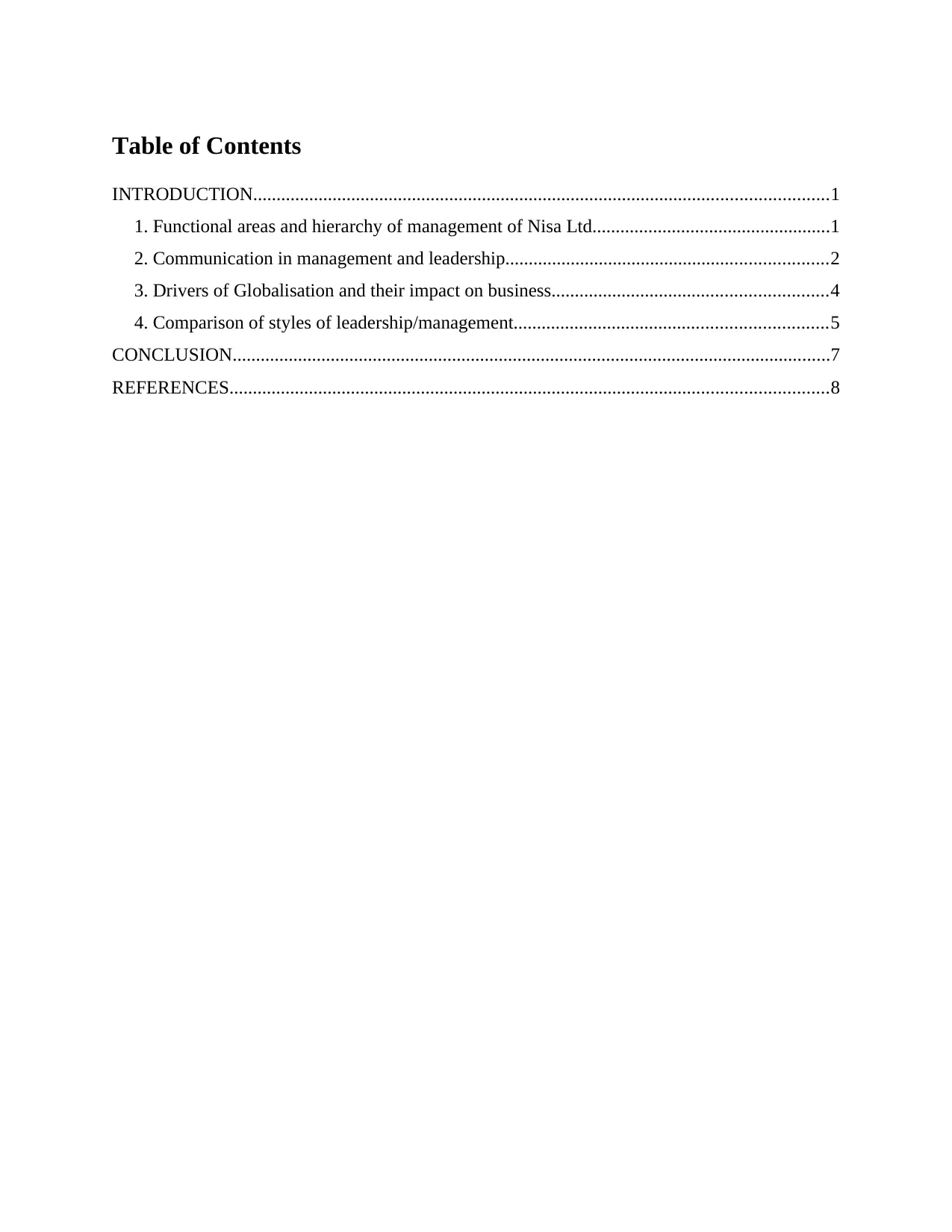
Table of Contents
INTRODUCTION...........................................................................................................................1
1. Functional areas and hierarchy of management of Nisa Ltd...................................................1
2. Communication in management and leadership.....................................................................2
3. Drivers of Globalisation and their impact on business...........................................................4
4. Comparison of styles of leadership/management...................................................................5
CONCLUSION................................................................................................................................7
REFERENCES................................................................................................................................8
INTRODUCTION...........................................................................................................................1
1. Functional areas and hierarchy of management of Nisa Ltd...................................................1
2. Communication in management and leadership.....................................................................2
3. Drivers of Globalisation and their impact on business...........................................................4
4. Comparison of styles of leadership/management...................................................................5
CONCLUSION................................................................................................................................7
REFERENCES................................................................................................................................8
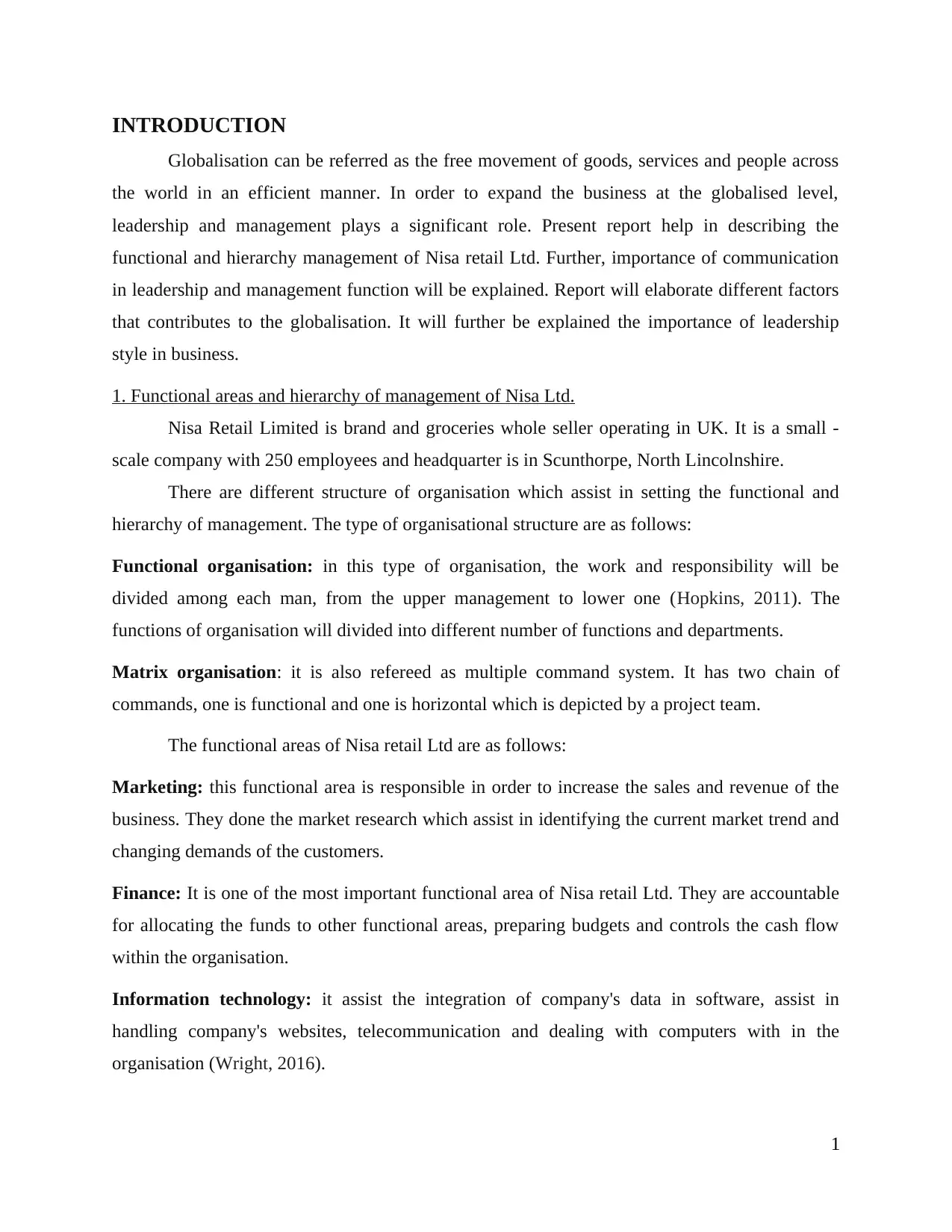
INTRODUCTION
Globalisation can be referred as the free movement of goods, services and people across
the world in an efficient manner. In order to expand the business at the globalised level,
leadership and management plays a significant role. Present report help in describing the
functional and hierarchy management of Nisa retail Ltd. Further, importance of communication
in leadership and management function will be explained. Report will elaborate different factors
that contributes to the globalisation. It will further be explained the importance of leadership
style in business.
1. Functional areas and hierarchy of management of Nisa Ltd.
Nisa Retail Limited is brand and groceries whole seller operating in UK. It is a small -
scale company with 250 employees and headquarter is in Scunthorpe, North Lincolnshire.
There are different structure of organisation which assist in setting the functional and
hierarchy of management. The type of organisational structure are as follows:
Functional organisation: in this type of organisation, the work and responsibility will be
divided among each man, from the upper management to lower one (Hopkins, 2011). The
functions of organisation will divided into different number of functions and departments.
Matrix organisation: it is also refereed as multiple command system. It has two chain of
commands, one is functional and one is horizontal which is depicted by a project team.
The functional areas of Nisa retail Ltd are as follows:
Marketing: this functional area is responsible in order to increase the sales and revenue of the
business. They done the market research which assist in identifying the current market trend and
changing demands of the customers.
Finance: It is one of the most important functional area of Nisa retail Ltd. They are accountable
for allocating the funds to other functional areas, preparing budgets and controls the cash flow
within the organisation.
Information technology: it assist the integration of company's data in software, assist in
handling company's websites, telecommunication and dealing with computers with in the
organisation (Wright, 2016).
1
Globalisation can be referred as the free movement of goods, services and people across
the world in an efficient manner. In order to expand the business at the globalised level,
leadership and management plays a significant role. Present report help in describing the
functional and hierarchy management of Nisa retail Ltd. Further, importance of communication
in leadership and management function will be explained. Report will elaborate different factors
that contributes to the globalisation. It will further be explained the importance of leadership
style in business.
1. Functional areas and hierarchy of management of Nisa Ltd.
Nisa Retail Limited is brand and groceries whole seller operating in UK. It is a small -
scale company with 250 employees and headquarter is in Scunthorpe, North Lincolnshire.
There are different structure of organisation which assist in setting the functional and
hierarchy of management. The type of organisational structure are as follows:
Functional organisation: in this type of organisation, the work and responsibility will be
divided among each man, from the upper management to lower one (Hopkins, 2011). The
functions of organisation will divided into different number of functions and departments.
Matrix organisation: it is also refereed as multiple command system. It has two chain of
commands, one is functional and one is horizontal which is depicted by a project team.
The functional areas of Nisa retail Ltd are as follows:
Marketing: this functional area is responsible in order to increase the sales and revenue of the
business. They done the market research which assist in identifying the current market trend and
changing demands of the customers.
Finance: It is one of the most important functional area of Nisa retail Ltd. They are accountable
for allocating the funds to other functional areas, preparing budgets and controls the cash flow
within the organisation.
Information technology: it assist the integration of company's data in software, assist in
handling company's websites, telecommunication and dealing with computers with in the
organisation (Wright, 2016).
1
⊘ This is a preview!⊘
Do you want full access?
Subscribe today to unlock all pages.

Trusted by 1+ million students worldwide
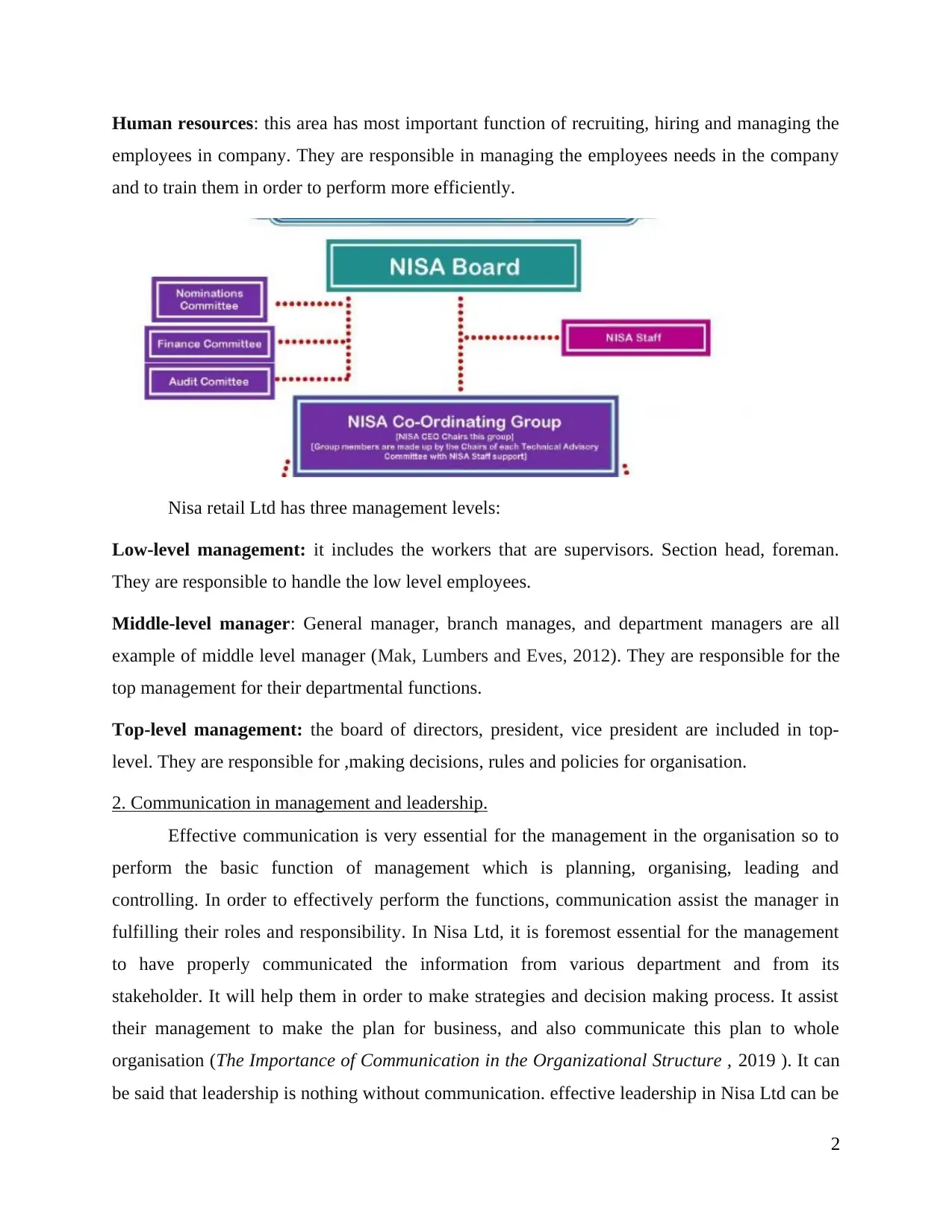
Human resources: this area has most important function of recruiting, hiring and managing the
employees in company. They are responsible in managing the employees needs in the company
and to train them in order to perform more efficiently.
Nisa retail Ltd has three management levels:
Low-level management: it includes the workers that are supervisors. Section head, foreman.
They are responsible to handle the low level employees.
Middle-level manager: General manager, branch manages, and department managers are all
example of middle level manager (Mak, Lumbers and Eves, 2012). They are responsible for the
top management for their departmental functions.
Top-level management: the board of directors, president, vice president are included in top-
level. They are responsible for ,making decisions, rules and policies for organisation.
2. Communication in management and leadership.
Effective communication is very essential for the management in the organisation so to
perform the basic function of management which is planning, organising, leading and
controlling. In order to effectively perform the functions, communication assist the manager in
fulfilling their roles and responsibility. In Nisa Ltd, it is foremost essential for the management
to have properly communicated the information from various department and from its
stakeholder. It will help them in order to make strategies and decision making process. It assist
their management to make the plan for business, and also communicate this plan to whole
organisation (The Importance of Communication in the Organizational Structure , 2019 ). It can
be said that leadership is nothing without communication. effective leadership in Nisa Ltd can be
2
employees in company. They are responsible in managing the employees needs in the company
and to train them in order to perform more efficiently.
Nisa retail Ltd has three management levels:
Low-level management: it includes the workers that are supervisors. Section head, foreman.
They are responsible to handle the low level employees.
Middle-level manager: General manager, branch manages, and department managers are all
example of middle level manager (Mak, Lumbers and Eves, 2012). They are responsible for the
top management for their departmental functions.
Top-level management: the board of directors, president, vice president are included in top-
level. They are responsible for ,making decisions, rules and policies for organisation.
2. Communication in management and leadership.
Effective communication is very essential for the management in the organisation so to
perform the basic function of management which is planning, organising, leading and
controlling. In order to effectively perform the functions, communication assist the manager in
fulfilling their roles and responsibility. In Nisa Ltd, it is foremost essential for the management
to have properly communicated the information from various department and from its
stakeholder. It will help them in order to make strategies and decision making process. It assist
their management to make the plan for business, and also communicate this plan to whole
organisation (The Importance of Communication in the Organizational Structure , 2019 ). It can
be said that leadership is nothing without communication. effective leadership in Nisa Ltd can be
2
Paraphrase This Document
Need a fresh take? Get an instant paraphrase of this document with our AI Paraphraser
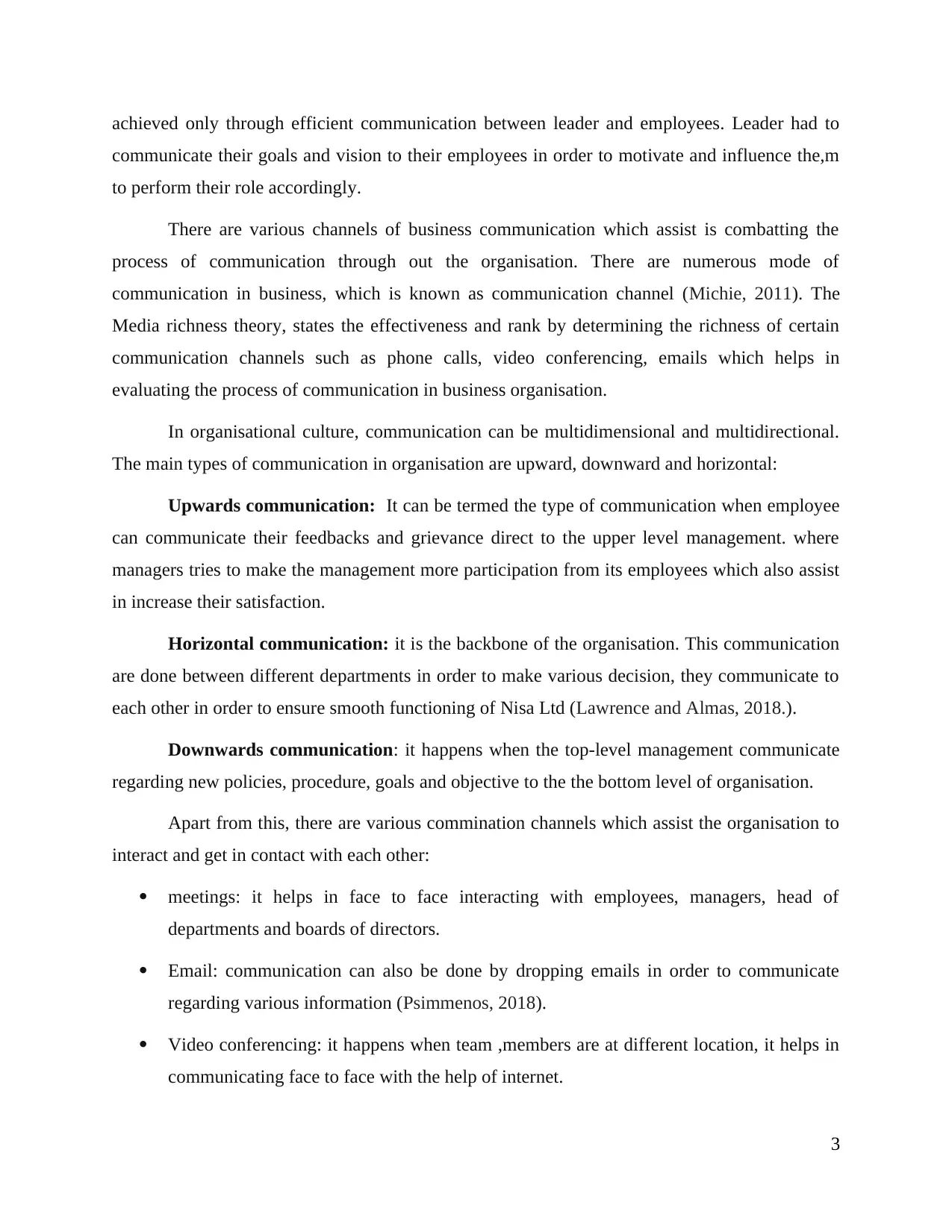
achieved only through efficient communication between leader and employees. Leader had to
communicate their goals and vision to their employees in order to motivate and influence the,m
to perform their role accordingly.
There are various channels of business communication which assist is combatting the
process of communication through out the organisation. There are numerous mode of
communication in business, which is known as communication channel (Michie, 2011). The
Media richness theory, states the effectiveness and rank by determining the richness of certain
communication channels such as phone calls, video conferencing, emails which helps in
evaluating the process of communication in business organisation.
In organisational culture, communication can be multidimensional and multidirectional.
The main types of communication in organisation are upward, downward and horizontal:
Upwards communication: It can be termed the type of communication when employee
can communicate their feedbacks and grievance direct to the upper level management. where
managers tries to make the management more participation from its employees which also assist
in increase their satisfaction.
Horizontal communication: it is the backbone of the organisation. This communication
are done between different departments in order to make various decision, they communicate to
each other in order to ensure smooth functioning of Nisa Ltd (Lawrence and Almas, 2018.).
Downwards communication: it happens when the top-level management communicate
regarding new policies, procedure, goals and objective to the the bottom level of organisation.
Apart from this, there are various commination channels which assist the organisation to
interact and get in contact with each other:
meetings: it helps in face to face interacting with employees, managers, head of
departments and boards of directors.
Email: communication can also be done by dropping emails in order to communicate
regarding various information (Psimmenos, 2018).
Video conferencing: it happens when team ,members are at different location, it helps in
communicating face to face with the help of internet.
3
communicate their goals and vision to their employees in order to motivate and influence the,m
to perform their role accordingly.
There are various channels of business communication which assist is combatting the
process of communication through out the organisation. There are numerous mode of
communication in business, which is known as communication channel (Michie, 2011). The
Media richness theory, states the effectiveness and rank by determining the richness of certain
communication channels such as phone calls, video conferencing, emails which helps in
evaluating the process of communication in business organisation.
In organisational culture, communication can be multidimensional and multidirectional.
The main types of communication in organisation are upward, downward and horizontal:
Upwards communication: It can be termed the type of communication when employee
can communicate their feedbacks and grievance direct to the upper level management. where
managers tries to make the management more participation from its employees which also assist
in increase their satisfaction.
Horizontal communication: it is the backbone of the organisation. This communication
are done between different departments in order to make various decision, they communicate to
each other in order to ensure smooth functioning of Nisa Ltd (Lawrence and Almas, 2018.).
Downwards communication: it happens when the top-level management communicate
regarding new policies, procedure, goals and objective to the the bottom level of organisation.
Apart from this, there are various commination channels which assist the organisation to
interact and get in contact with each other:
meetings: it helps in face to face interacting with employees, managers, head of
departments and boards of directors.
Email: communication can also be done by dropping emails in order to communicate
regarding various information (Psimmenos, 2018).
Video conferencing: it happens when team ,members are at different location, it helps in
communicating face to face with the help of internet.
3
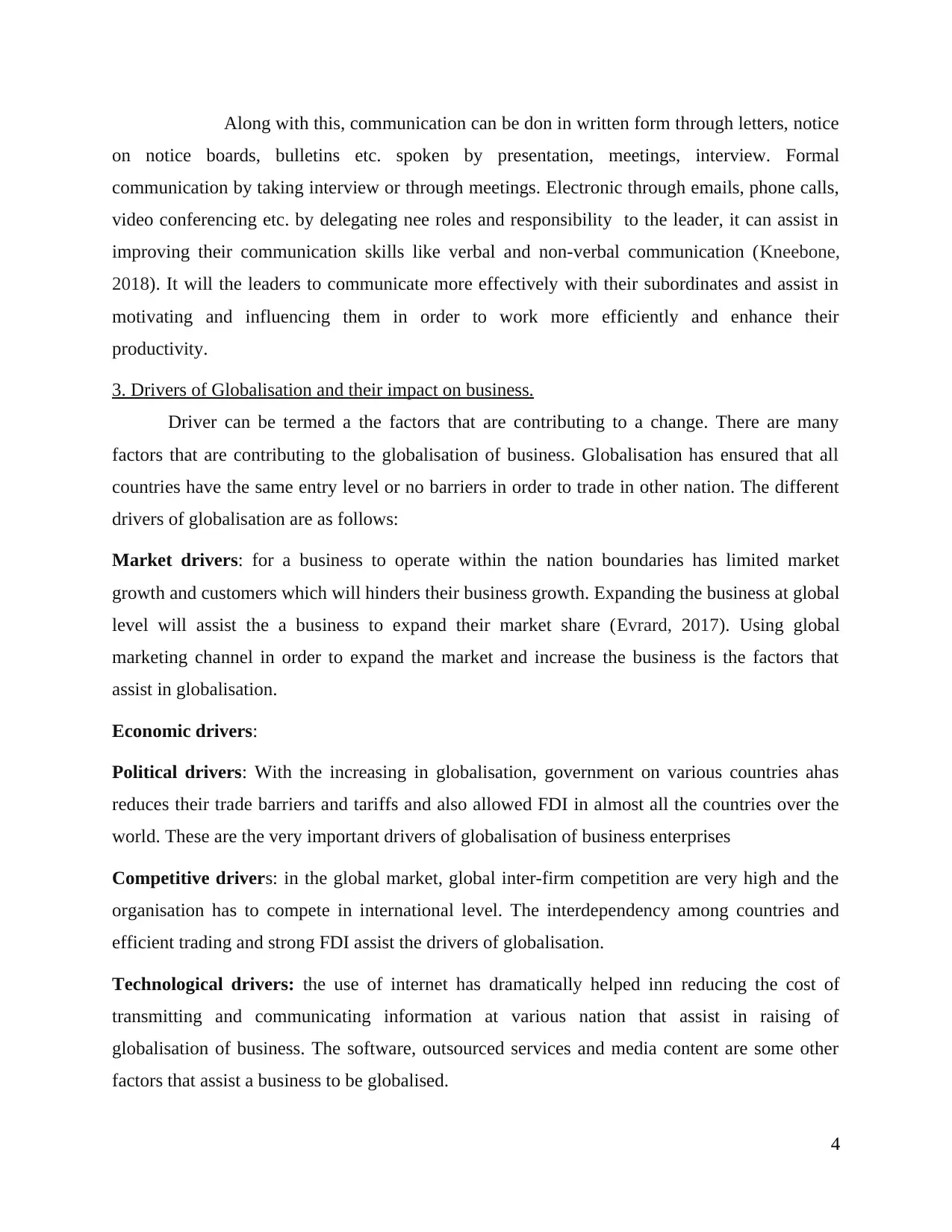
Along with this, communication can be don in written form through letters, notice
on notice boards, bulletins etc. spoken by presentation, meetings, interview. Formal
communication by taking interview or through meetings. Electronic through emails, phone calls,
video conferencing etc. by delegating nee roles and responsibility to the leader, it can assist in
improving their communication skills like verbal and non-verbal communication (Kneebone,
2018). It will the leaders to communicate more effectively with their subordinates and assist in
motivating and influencing them in order to work more efficiently and enhance their
productivity.
3. Drivers of Globalisation and their impact on business.
Driver can be termed a the factors that are contributing to a change. There are many
factors that are contributing to the globalisation of business. Globalisation has ensured that all
countries have the same entry level or no barriers in order to trade in other nation. The different
drivers of globalisation are as follows:
Market drivers: for a business to operate within the nation boundaries has limited market
growth and customers which will hinders their business growth. Expanding the business at global
level will assist the a business to expand their market share (Evrard, 2017). Using global
marketing channel in order to expand the market and increase the business is the factors that
assist in globalisation.
Economic drivers:
Political drivers: With the increasing in globalisation, government on various countries ahas
reduces their trade barriers and tariffs and also allowed FDI in almost all the countries over the
world. These are the very important drivers of globalisation of business enterprises
Competitive drivers: in the global market, global inter-firm competition are very high and the
organisation has to compete in international level. The interdependency among countries and
efficient trading and strong FDI assist the drivers of globalisation.
Technological drivers: the use of internet has dramatically helped inn reducing the cost of
transmitting and communicating information at various nation that assist in raising of
globalisation of business. The software, outsourced services and media content are some other
factors that assist a business to be globalised.
4
on notice boards, bulletins etc. spoken by presentation, meetings, interview. Formal
communication by taking interview or through meetings. Electronic through emails, phone calls,
video conferencing etc. by delegating nee roles and responsibility to the leader, it can assist in
improving their communication skills like verbal and non-verbal communication (Kneebone,
2018). It will the leaders to communicate more effectively with their subordinates and assist in
motivating and influencing them in order to work more efficiently and enhance their
productivity.
3. Drivers of Globalisation and their impact on business.
Driver can be termed a the factors that are contributing to a change. There are many
factors that are contributing to the globalisation of business. Globalisation has ensured that all
countries have the same entry level or no barriers in order to trade in other nation. The different
drivers of globalisation are as follows:
Market drivers: for a business to operate within the nation boundaries has limited market
growth and customers which will hinders their business growth. Expanding the business at global
level will assist the a business to expand their market share (Evrard, 2017). Using global
marketing channel in order to expand the market and increase the business is the factors that
assist in globalisation.
Economic drivers:
Political drivers: With the increasing in globalisation, government on various countries ahas
reduces their trade barriers and tariffs and also allowed FDI in almost all the countries over the
world. These are the very important drivers of globalisation of business enterprises
Competitive drivers: in the global market, global inter-firm competition are very high and the
organisation has to compete in international level. The interdependency among countries and
efficient trading and strong FDI assist the drivers of globalisation.
Technological drivers: the use of internet has dramatically helped inn reducing the cost of
transmitting and communicating information at various nation that assist in raising of
globalisation of business. The software, outsourced services and media content are some other
factors that assist a business to be globalised.
4
⊘ This is a preview!⊘
Do you want full access?
Subscribe today to unlock all pages.

Trusted by 1+ million students worldwide
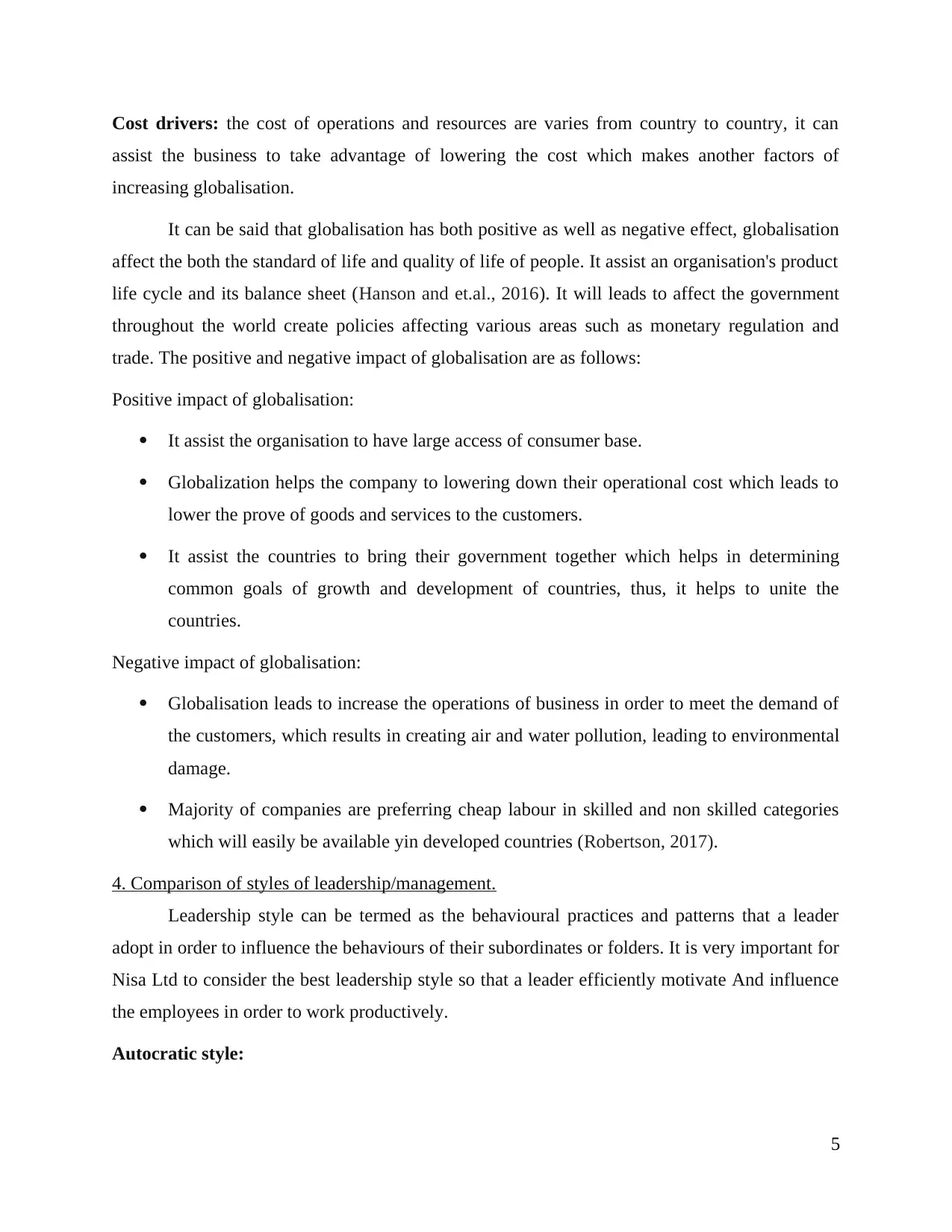
Cost drivers: the cost of operations and resources are varies from country to country, it can
assist the business to take advantage of lowering the cost which makes another factors of
increasing globalisation.
It can be said that globalisation has both positive as well as negative effect, globalisation
affect the both the standard of life and quality of life of people. It assist an organisation's product
life cycle and its balance sheet (Hanson and et.al., 2016). It will leads to affect the government
throughout the world create policies affecting various areas such as monetary regulation and
trade. The positive and negative impact of globalisation are as follows:
Positive impact of globalisation:
It assist the organisation to have large access of consumer base.
Globalization helps the company to lowering down their operational cost which leads to
lower the prove of goods and services to the customers.
It assist the countries to bring their government together which helps in determining
common goals of growth and development of countries, thus, it helps to unite the
countries.
Negative impact of globalisation:
Globalisation leads to increase the operations of business in order to meet the demand of
the customers, which results in creating air and water pollution, leading to environmental
damage.
Majority of companies are preferring cheap labour in skilled and non skilled categories
which will easily be available yin developed countries (Robertson, 2017).
4. Comparison of styles of leadership/management.
Leadership style can be termed as the behavioural practices and patterns that a leader
adopt in order to influence the behaviours of their subordinates or folders. It is very important for
Nisa Ltd to consider the best leadership style so that a leader efficiently motivate And influence
the employees in order to work productively.
Autocratic style:
5
assist the business to take advantage of lowering the cost which makes another factors of
increasing globalisation.
It can be said that globalisation has both positive as well as negative effect, globalisation
affect the both the standard of life and quality of life of people. It assist an organisation's product
life cycle and its balance sheet (Hanson and et.al., 2016). It will leads to affect the government
throughout the world create policies affecting various areas such as monetary regulation and
trade. The positive and negative impact of globalisation are as follows:
Positive impact of globalisation:
It assist the organisation to have large access of consumer base.
Globalization helps the company to lowering down their operational cost which leads to
lower the prove of goods and services to the customers.
It assist the countries to bring their government together which helps in determining
common goals of growth and development of countries, thus, it helps to unite the
countries.
Negative impact of globalisation:
Globalisation leads to increase the operations of business in order to meet the demand of
the customers, which results in creating air and water pollution, leading to environmental
damage.
Majority of companies are preferring cheap labour in skilled and non skilled categories
which will easily be available yin developed countries (Robertson, 2017).
4. Comparison of styles of leadership/management.
Leadership style can be termed as the behavioural practices and patterns that a leader
adopt in order to influence the behaviours of their subordinates or folders. It is very important for
Nisa Ltd to consider the best leadership style so that a leader efficiently motivate And influence
the employees in order to work productively.
Autocratic style:
5
Paraphrase This Document
Need a fresh take? Get an instant paraphrase of this document with our AI Paraphraser
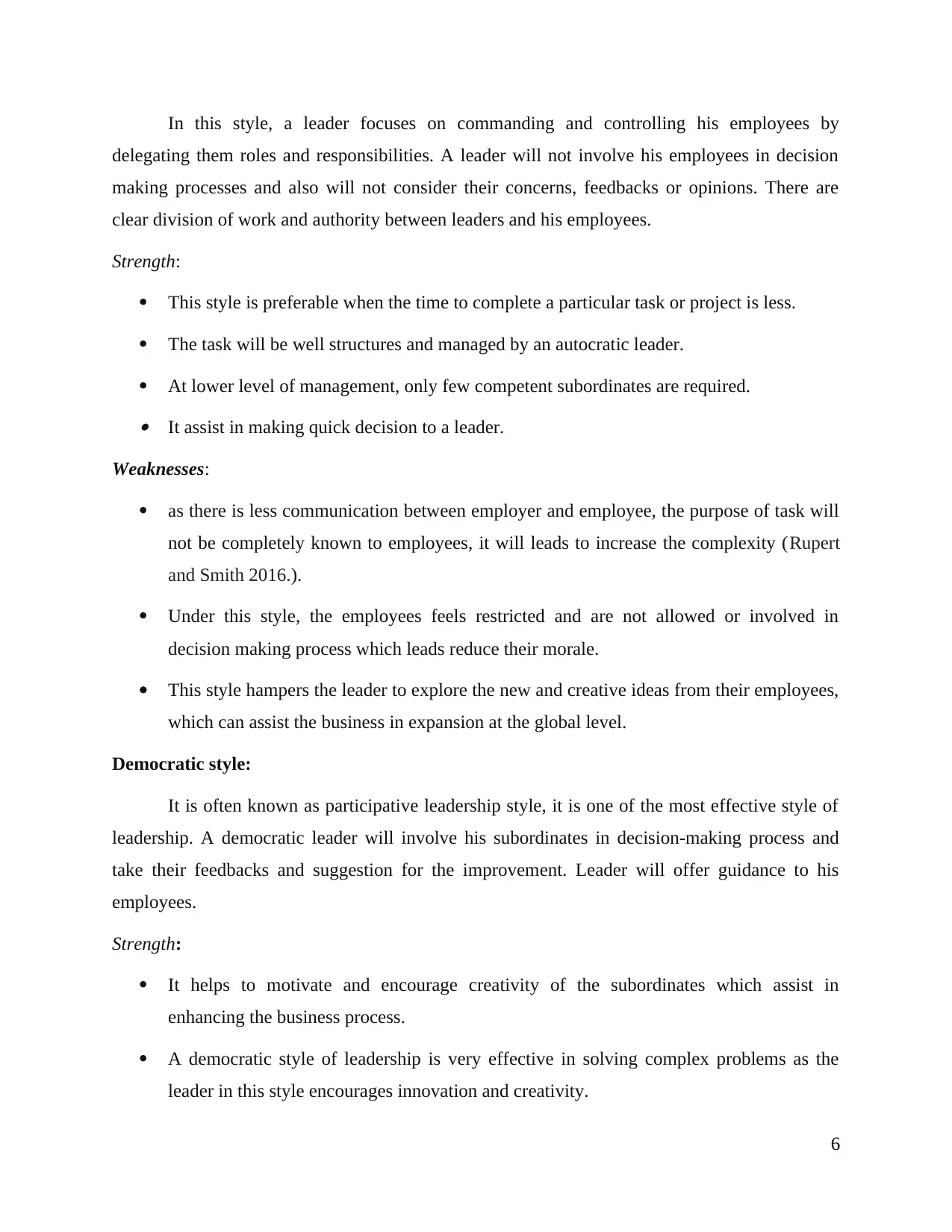
In this style, a leader focuses on commanding and controlling his employees by
delegating them roles and responsibilities. A leader will not involve his employees in decision
making processes and also will not consider their concerns, feedbacks or opinions. There are
clear division of work and authority between leaders and his employees.
Strength:
This style is preferable when the time to complete a particular task or project is less.
The task will be well structures and managed by an autocratic leader.
At lower level of management, only few competent subordinates are required. It assist in making quick decision to a leader.
Weaknesses:
as there is less communication between employer and employee, the purpose of task will
not be completely known to employees, it will leads to increase the complexity (Rupert
and Smith 2016.).
Under this style, the employees feels restricted and are not allowed or involved in
decision making process which leads reduce their morale.
This style hampers the leader to explore the new and creative ideas from their employees,
which can assist the business in expansion at the global level.
Democratic style:
It is often known as participative leadership style, it is one of the most effective style of
leadership. A democratic leader will involve his subordinates in decision-making process and
take their feedbacks and suggestion for the improvement. Leader will offer guidance to his
employees.
Strength:
It helps to motivate and encourage creativity of the subordinates which assist in
enhancing the business process.
A democratic style of leadership is very effective in solving complex problems as the
leader in this style encourages innovation and creativity.
6
delegating them roles and responsibilities. A leader will not involve his employees in decision
making processes and also will not consider their concerns, feedbacks or opinions. There are
clear division of work and authority between leaders and his employees.
Strength:
This style is preferable when the time to complete a particular task or project is less.
The task will be well structures and managed by an autocratic leader.
At lower level of management, only few competent subordinates are required. It assist in making quick decision to a leader.
Weaknesses:
as there is less communication between employer and employee, the purpose of task will
not be completely known to employees, it will leads to increase the complexity (Rupert
and Smith 2016.).
Under this style, the employees feels restricted and are not allowed or involved in
decision making process which leads reduce their morale.
This style hampers the leader to explore the new and creative ideas from their employees,
which can assist the business in expansion at the global level.
Democratic style:
It is often known as participative leadership style, it is one of the most effective style of
leadership. A democratic leader will involve his subordinates in decision-making process and
take their feedbacks and suggestion for the improvement. Leader will offer guidance to his
employees.
Strength:
It helps to motivate and encourage creativity of the subordinates which assist in
enhancing the business process.
A democratic style of leadership is very effective in solving complex problems as the
leader in this style encourages innovation and creativity.
6
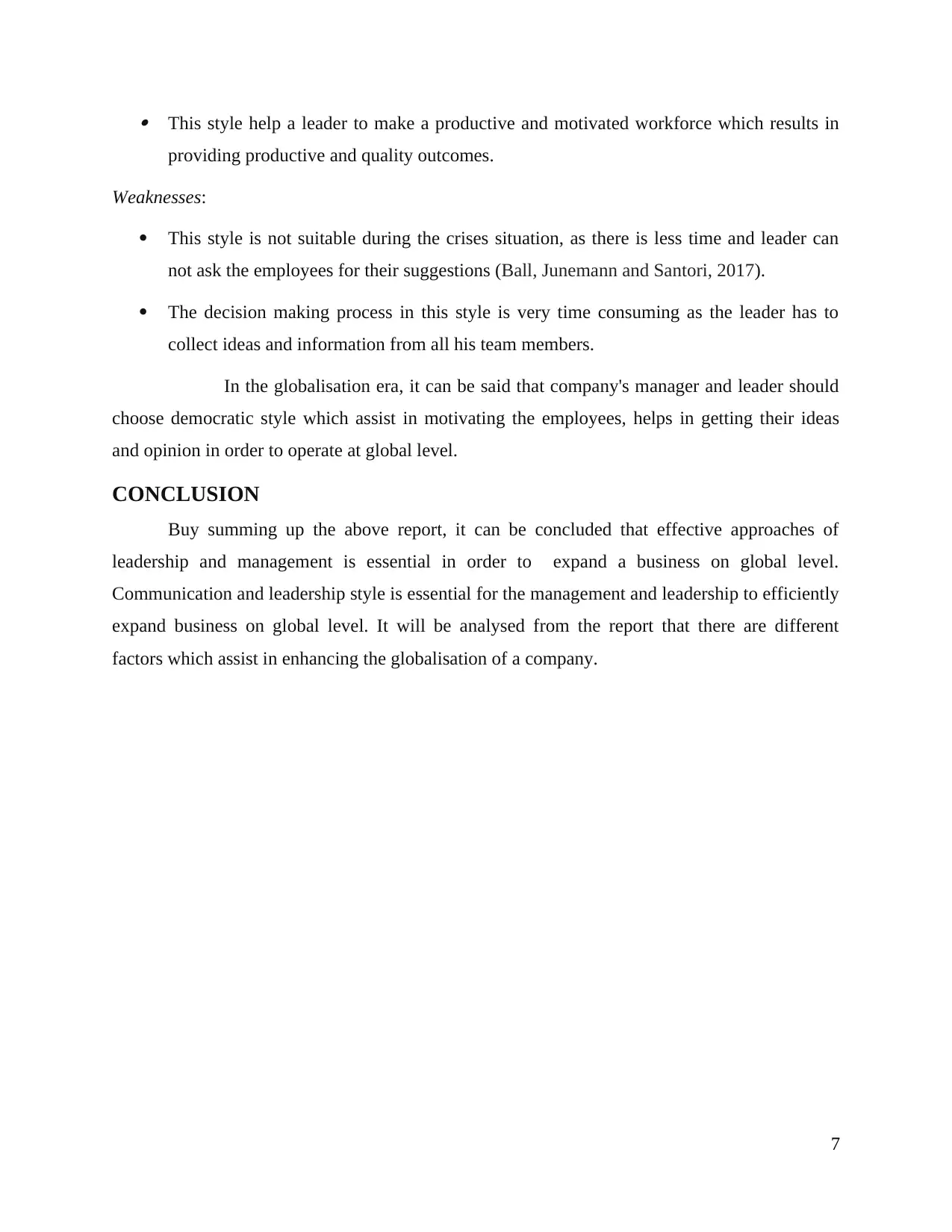
This style help a leader to make a productive and motivated workforce which results in
providing productive and quality outcomes.
Weaknesses:
This style is not suitable during the crises situation, as there is less time and leader can
not ask the employees for their suggestions (Ball, Junemann and Santori, 2017).
The decision making process in this style is very time consuming as the leader has to
collect ideas and information from all his team members.
In the globalisation era, it can be said that company's manager and leader should
choose democratic style which assist in motivating the employees, helps in getting their ideas
and opinion in order to operate at global level.
CONCLUSION
Buy summing up the above report, it can be concluded that effective approaches of
leadership and management is essential in order to expand a business on global level.
Communication and leadership style is essential for the management and leadership to efficiently
expand business on global level. It will be analysed from the report that there are different
factors which assist in enhancing the globalisation of a company.
7
providing productive and quality outcomes.
Weaknesses:
This style is not suitable during the crises situation, as there is less time and leader can
not ask the employees for their suggestions (Ball, Junemann and Santori, 2017).
The decision making process in this style is very time consuming as the leader has to
collect ideas and information from all his team members.
In the globalisation era, it can be said that company's manager and leader should
choose democratic style which assist in motivating the employees, helps in getting their ideas
and opinion in order to operate at global level.
CONCLUSION
Buy summing up the above report, it can be concluded that effective approaches of
leadership and management is essential in order to expand a business on global level.
Communication and leadership style is essential for the management and leadership to efficiently
expand business on global level. It will be analysed from the report that there are different
factors which assist in enhancing the globalisation of a company.
7
⊘ This is a preview!⊘
Do you want full access?
Subscribe today to unlock all pages.

Trusted by 1+ million students worldwide
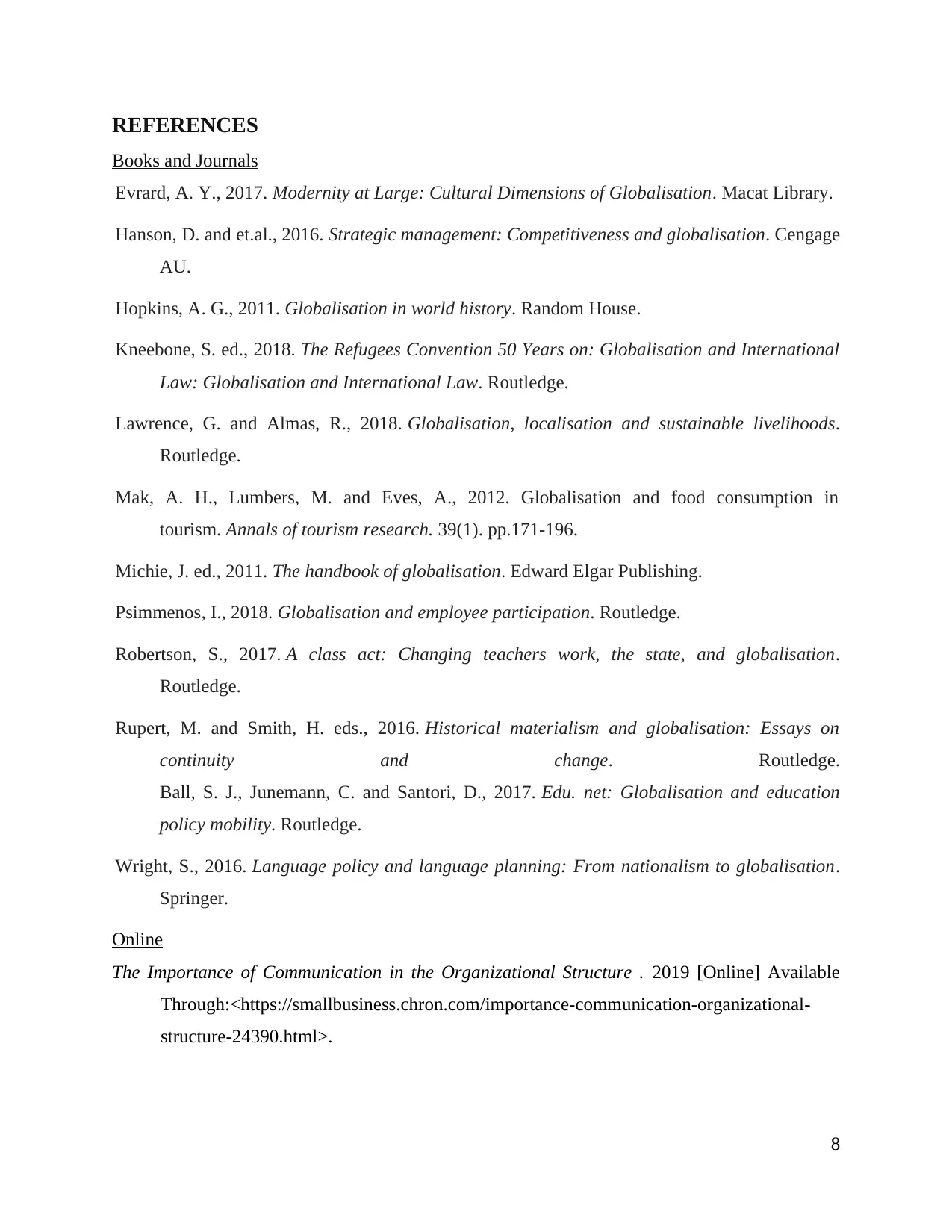
REFERENCES
Books and Journals
Evrard, A. Y., 2017. Modernity at Large: Cultural Dimensions of Globalisation. Macat Library.
Hanson, D. and et.al., 2016. Strategic management: Competitiveness and globalisation. Cengage
AU.
Hopkins, A. G., 2011. Globalisation in world history. Random House.
Kneebone, S. ed., 2018. The Refugees Convention 50 Years on: Globalisation and International
Law: Globalisation and International Law. Routledge.
Lawrence, G. and Almas, R., 2018. Globalisation, localisation and sustainable livelihoods.
Routledge.
Mak, A. H., Lumbers, M. and Eves, A., 2012. Globalisation and food consumption in
tourism. Annals of tourism research. 39(1). pp.171-196.
Michie, J. ed., 2011. The handbook of globalisation. Edward Elgar Publishing.
Psimmenos, I., 2018. Globalisation and employee participation. Routledge.
Robertson, S., 2017. A class act: Changing teachers work, the state, and globalisation.
Routledge.
Rupert, M. and Smith, H. eds., 2016. Historical materialism and globalisation: Essays on
continuity and change. Routledge.
Ball, S. J., Junemann, C. and Santori, D., 2017. Edu. net: Globalisation and education
policy mobility. Routledge.
Wright, S., 2016. Language policy and language planning: From nationalism to globalisation.
Springer.
Online
The Importance of Communication in the Organizational Structure . 2019 [Online] Available
Through:<https://smallbusiness.chron.com/importance-communication-organizational-
structure-24390.html>.
8
Books and Journals
Evrard, A. Y., 2017. Modernity at Large: Cultural Dimensions of Globalisation. Macat Library.
Hanson, D. and et.al., 2016. Strategic management: Competitiveness and globalisation. Cengage
AU.
Hopkins, A. G., 2011. Globalisation in world history. Random House.
Kneebone, S. ed., 2018. The Refugees Convention 50 Years on: Globalisation and International
Law: Globalisation and International Law. Routledge.
Lawrence, G. and Almas, R., 2018. Globalisation, localisation and sustainable livelihoods.
Routledge.
Mak, A. H., Lumbers, M. and Eves, A., 2012. Globalisation and food consumption in
tourism. Annals of tourism research. 39(1). pp.171-196.
Michie, J. ed., 2011. The handbook of globalisation. Edward Elgar Publishing.
Psimmenos, I., 2018. Globalisation and employee participation. Routledge.
Robertson, S., 2017. A class act: Changing teachers work, the state, and globalisation.
Routledge.
Rupert, M. and Smith, H. eds., 2016. Historical materialism and globalisation: Essays on
continuity and change. Routledge.
Ball, S. J., Junemann, C. and Santori, D., 2017. Edu. net: Globalisation and education
policy mobility. Routledge.
Wright, S., 2016. Language policy and language planning: From nationalism to globalisation.
Springer.
Online
The Importance of Communication in the Organizational Structure . 2019 [Online] Available
Through:<https://smallbusiness.chron.com/importance-communication-organizational-
structure-24390.html>.
8
Paraphrase This Document
Need a fresh take? Get an instant paraphrase of this document with our AI Paraphraser

5 Drivers of Globalization . 2019 [Online] Available Through:<https://www.cio.com/article/2447695/it-
organization/5-drivers-of-globalization.html>.
9
organization/5-drivers-of-globalization.html>.
9
1 out of 11
Related Documents
Your All-in-One AI-Powered Toolkit for Academic Success.
+13062052269
info@desklib.com
Available 24*7 on WhatsApp / Email
![[object Object]](/_next/static/media/star-bottom.7253800d.svg)
Unlock your academic potential
Copyright © 2020–2025 A2Z Services. All Rights Reserved. Developed and managed by ZUCOL.


